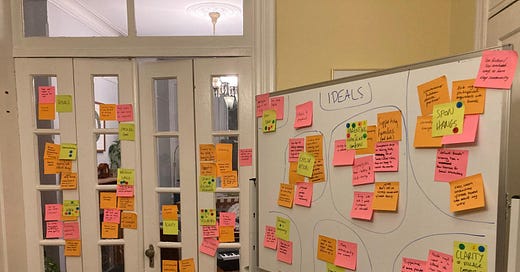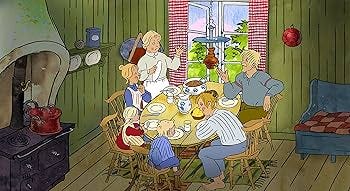I recently spoke to a man in his forties who told me he’d been thinking about what we would choose if we just arrived on the planet. Would our lives look as they do now?
He thought no. He’d want much more devoted friendships than are the norm now. (Especially for straight men of his age).
Apply that same question to parenting. What would we choose? Is it the two-parent family ideal, with a detached house and a backyard? Some people surely would prefer this above all other setups. But I’m doubtful that as many people would have that arrangement as currently do in the US.
I’m excited to share this article I wrote for The Atlantic about people who’ve established a different kind of family life, one that’s integrated with friends, showing the rewards and surprises along the way.
Working on the piece, I saw how parents often face a tradeoff between receiving support and exercising control over their kids’ lives. Many Americans have (sometimes inadvertently) sacrificed potential social support in favor of privacy and more control over their kids’ environment. And while visiting people with these housing setups, it also became clear to me that parenthood and friendship don’t have to be at odds. Quite the opposite is possible.
The backbone of the piece is a couple, Raffi and Charlotte Grinberg, who packed up their lives—and their four kids’ lives—to move next door to their longtime best friends. The housing decision that Raffi and Charlotte made is emblematic of Raffi’s guidance in his new book, How To Be a Grown Up — to get clear about what you value and to act on those values, regardless of norms. Highly recommend his book for anyone in their 20s and his Substack, also called
.There was so much that didn’t make it into this piece, but one I’ll flag is the experience of kids in these housing arrangements. The clear consensus was, young kids love it. For teens, it’s often a mixed bag (though, to be fair, are teens ever happy?) Specifically, adolescents don’t seem to enjoy having so many adult eyes around them when they just want to walk home with their crush and not have a bunch of people asking questions in the days after. This is something that actually happened to a 20-something I spoke to, who was raised in a co-housing community. But, in retrospect, this 20-something and the other now-grown kids I spoke to were grateful for the larger house life, the ease they feel being around adults who aren’t their relatives, and the experience navigating the complexities of community. So, from a kid’s perspective, there may be some temporary pain for serious longterm gain.
It was particularly meaningful to write this article at the same time that my friends and I have ramped up our effort to live together longterm. And a major reason people in the group want this arrangement is either to avoid the isolation of parenthood or to allow non-parents everyday involvement in kids’ lives. When we did an exercise brainstorming the ideals that could underlie a future housing setup, a major one was providing support and social connection for parents.
It’s a project we started calling “The Village” (though according to a friend of a friend, given the relatively small number of people involved, it’d be more appropriate to call it “The Hamlet.”) I’m keeping track of our process of creating The Hamlet, in case it might be useful for anyone in the future. (We’re leaning a lot on the insights of the Substack
). What would you want to know about building a shared living setup with friends?This won’t be my first time living with friends. My husband and I lived for several years with another couple and their children. Those friends have since moved to another city, and on our group chat this week, I got a little insight into how our past living arrangement has affected the kids.
My friend was reading her four-year-old a book called Michel by Astrid Lindgren (of Pippi Longstocking fame). Michel lives with his parents, sister and two other adults, Alfred and Lina, who work on his parents’ farm. The four-year-old wanted to understand how Michel relates to Alfred and Lina.
My friend explained that Alfred and Lina are Michel’s friends. And the boy said “like Coco and Rhaina.” (Coco is his nickname for my husband). Evidently, to this four-year-old, it makes sense to share a house with friends.
This small moment reveals something powerful: to this child, sharing a home with people beyond the nuclear family isn't strange—it's simply a way people can live. It's a reminder that what we consider "normal" is, in many cases, learned, not innate. The uncomplicated perspective of a child makes it easier to see how flexible our social arrangements could be.
Updates
It’s been a while since I last sent a newsletter. A few updates:
I so enjoyed this interview I got to do for TED Radio Hour
For paperback lovers: the paperback edition of my book comes out in June!
I’ve been working on a big podcast series for NPR’s Embedded that’ll be out in a few weeks. More on that soon.
I hope you’ll read the article and tell me what you think!






Loved your piece in the Atlantic, Rhaina!
What a great piece! It definitely reminded me of my former set-up in cohousing with a couple of families, and my new set-up with my brother and his family. (I consider my brother a best friend, so there's that.) I appreciated that you talked about both the many, many upsides, and the potential challenges. I think the biggest challenges for us in both arrangements have always been different seasons of challenging behavior with various kids and the adults' ability to get on the same page about how to handle it. Luckily I've been blessed with brave and informed co-parent friends who know how to talk about hard stuff, like consent expectations, neurodiversity, and so much more.